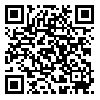Articles accepted at the time of publication
Back to the articles list |
Back to browse issues page
1- Associate Professor of Persian Language and Literature, Department Faculty of Humanities, Kosar University of Bojnord, Bojnord, Iran , ebrahimkanani@kub.ac.ir
2- Assistant Professor of Persian Language and Literature, Department Faculty of Humanities, Kosar University of Bojnord, Bojnord, Iran.
2- Assistant Professor of Persian Language and Literature, Department Faculty of Humanities, Kosar University of Bojnord, Bojnord, Iran.
Abstract: (1590 Views)
In semiotics, the denotative relationship is established between the three aspects of the sign, the object, and the interpretation of the same sign, and symbolic processes find endless meanings and this relationship classifies the symbolic, indexical and iconic species. Proverbs are taken from the context of a linguistic community that form multiple meanings and show gender construction. with semiotic studies, the significations of the opposition between man and woman in proverbs can be investigated. In this article, the concept of gender in proverbs of Tati language is investigated with Peirce's semiotic model in order to evaluate and analyze the reflection of their linguistic elements in all kinds of signs. Based on the result, Tati proverbs are mostly in the form of symbolic signs. The highest frequency is objectification and then otherness. The symbolic contrast between male and female gender and the discourse order and hierarchical position of this concept in the form of ideas of superiority/inferiority, value/worthless, human/animal, authoritarianism/weakening, center/periphery, self/other, norm/abnormal, friend/ Enemy and Dominant/Dominant have been classified and conceptualized. This opposition represents the idea of the otherness of the female gender and the superiority of the male gender over it as a dominant discourse. Based on this, the gender structure of this concept can be shaped in relation to the language type of Tat tribes of Northern Khorasan.
Article Type: مقالات علمی پژوهشی |
Subject:
Semiotics
Send email to the article author
| Rights and permissions | |
 |
This work is licensed under a Creative Commons Attribution-NonCommercial 4.0 International License. |







